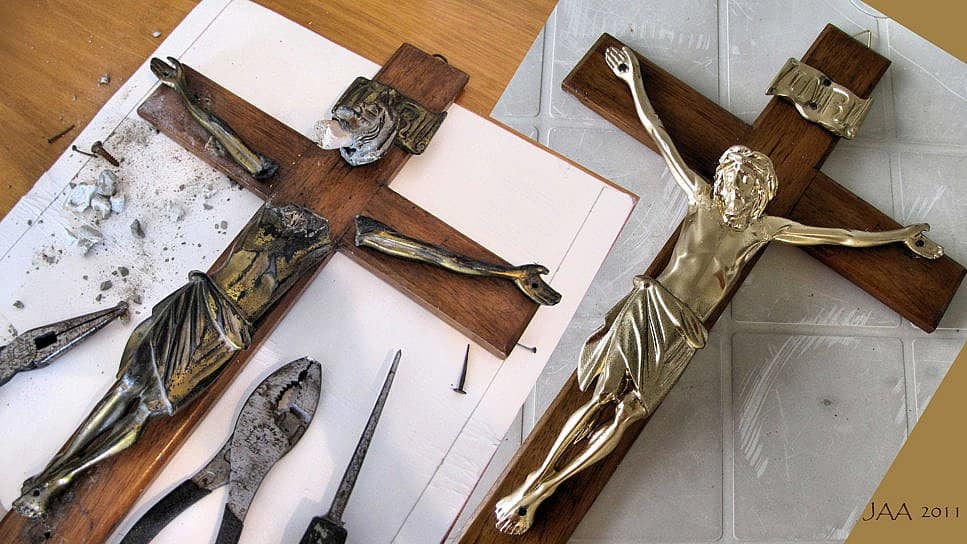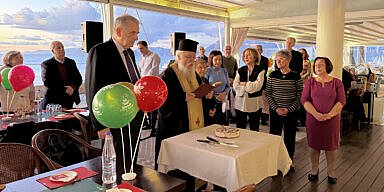It arrived at my home, near Patra, inside a grungy plastic bucket, once used for house paint. I was waiting for It, not quite knowing what to expect. A cousin had told me that they had this old, broken Cross, they had previously tried to fix, and they were ready to throw it away. But, she thought, maybe I, with my interest in crafts, could try to fix it. And I had said that I’d give it a try.
So, I looked inside the bucket. And thus, I received the initial shock: There were pieces of wood, metal parts, yellowed newspaper, and lots of dirt and dust, all rolling around at the bottom. A whole bunch of pieces, battered and unrecognizable. They had obviously occupied that bucket for years! My original expectations of some cleaning and minor restoration were dissolved!
With rapidly failing expectations, I started taking the pieces out of the bucket and laying them out on a table. They were parts of a Crucifix. There was the head, separated, with a piece of wood dowel stuck for the neck, apparently an attempt at a previous repair. I found the outstretched left arm, broken at the shoulder. Then, the right arm, also broken, and then the body, with part of the upper chest missing. Then, there was also the traditional sign: “INRI.” All these pieces were made of metal – some form of zinc casting, with a faint remnant, here and there, of a once bright gold finish. Luckily, the wooden Cross, aside from being very dirty, was in good condition.
I laid out the pieces loosely on the table to see what was missing and if the pieces would match and fit again. It was then that I received my major shock: Once assembled – more or less – it triggered my childhood memory: This was the very Crucifix that hung on the wall, over my bed, when I was a child in Greece, before my folks and I came to America as immigrants – 55 years before!
The emotions, upon recognizing this destroyed but suddenly precious object, can only be imagined! Long forgotten, it brought back the sadness, pain, and fear – yes, fear – of the immigrant, who leaves one’s home to go to a foreign land, and the many oh so dear things he leaves behind: Family, friends, neighborhoods, schools, language, customs, way of life, and the hundreds of big and little familiar, beloved objects that could not fit in the stuffed luggage one carries off. The immigrant’s emotions were, in those days, magnified further, because this pain of leaving one’s “world” was accentuated by the knowledge that the odds of ever returning to one’s homeland was, at best, remote, and at worst, impossible. Today, a new wave of migrants are leaving Greece, but the times are such that they know that they will be returning back – at least to visit – often. But to the immigrants of old, it was a nearly permanent separation from their “world,” and everything in it. The best they could hope for was for a letter that took about a month to travel across the seas. Those letters were the very thin, thin, precious ties with “home.”
So, with these emotions in my breast, I determined to reconstruct somehow this precious object of devotion, this holy Crucifix that hung over my bed when I was a child. It took the best part of a month, and some nonexistent skills that I had to learn, but in the end, a passable return to its former self was done. I took the liberty of placing a sort of “time capsule” inside the hollow casting, a hand-written note of who I was, what this Crucifix meant to me, and some dates. Perhaps it will survive for generations, and someday, another person may try to restore it again and will find and read a bit of personal history, from someone long gone.
Is there a Crucifix above your children’s bed?



